DET Prep Course: Write about the Photo Questions
This post provides a comprehensive guide for describing photos in the Duolingo English Test, specifically focusing on the “Write about the Photo” task. It covers four main categories: People, Animals, Scenery, and Objects. For each category, the guide offers detailed strategies, templates, and examples to help test-takers craft thorough and engaging descriptions.
Key points include:
The guide emphasizes the importance of not just listing visible elements, but also interpreting the mood, context, and significance of the scene or object depicted.
Table of Contents
- Introduction to the Duolingo English Test
- Understanding the Scoring Criteria
- Write About the Photo Task Instructions
- Overview of Question Categories
- Mastering People-Related Questions
- Approach Guidelines
- Templates and Examples
- Vocabulary for Describing People
- Describing Animals in Photos
- Approach Guidelines
- Templates for Single and Multiple Animals
- Examples
- Capturing Scenery in Words
- Approach Guidelines
- Vocabulary for Describing Scenery
- Templates and Examples
- Detailed Object Descriptions
- Approach Guidelines
- Templates and Examples
- Putting It All Together: Practice and Conclusion
Introduction
Hello, welcome to the Duolingo English Test Preparation Hub. Today, we’re going to explain a question type called Write about the Photo. Before we dive into the specifics, please note that all the photos used in this lesson are either AI-generated or copyright-free stock photos.
Understanding the Scoring Criteria
Alright, now, before we discuss the question formally, let’s first understand the scoring criteria for the writing section of the Duolingo English Test.
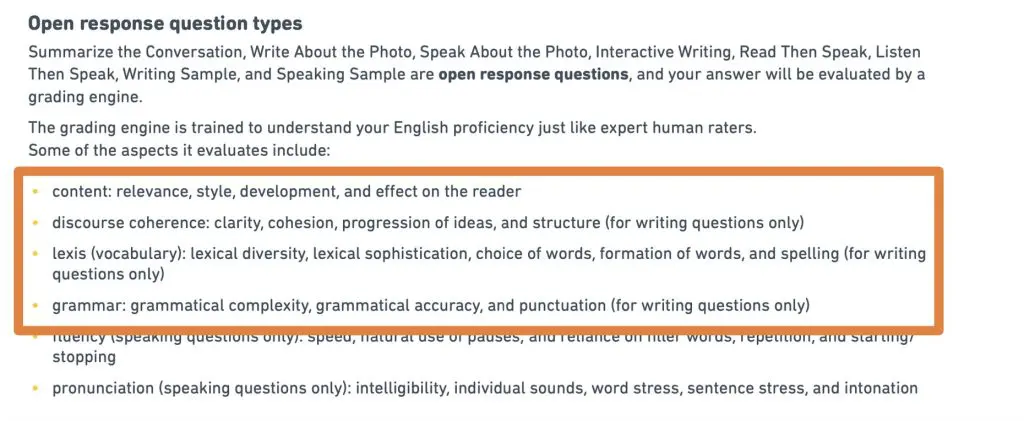
Since we’re discussing writing tasks, we can focus directly on the “Open Response Question Types” section. Let’s start with the grammar component: In this area, grammatical accuracy and complexity, along with proper punctuation usage, are key scoring criteria. Moreover, when writing, we should aim to eliminate grammatical and syntactical errors. This includes ensuring subject-verb agreement, where the subject and verb agree in number; using singular and plural forms correctly; applying articles such as “a,” “an,” and “the” appropriately; capitalizing words properly, especially at the beginning of sentences and for proper nouns; spelling all words correctly; and using punctuation marks appropriately.
Paying attention to these details can make our expression more accurate and clearer and improve the overall quality of our language. You can use longer sentences and complex sentence structures (compound and complex sentences) to achieve a higher score.
Move on to the content,when composing your response, it’s crucial to stay focused on the topic at hand and maintain relevance throughout. Take the time to develop your ideas thoroughly, providing sufficient detail and explanation to support your points. Employ an engaging writing style that captures and holds the reader’s attention. Your goal should be to create a strong impact on the reader, leaving them with a lasting impression of your message. Finally, ensure that your response is well-crafted and persuasive, using logical arguments, compelling evidence, and a clear structure.
Then let’s check discourse coherence,Clarity is paramount in effective communication, so ensure your writing is easy to understand for your intended audience. Utilize cohesive devices such as transitional phrases and conjunctions to link your ideas smoothly, creating a seamless flow between sentences and paragraphs. Present your ideas in a logical, progressive order that builds upon each point, leading the reader naturally from one concept to the next. Structure your response with a clear introduction that outlines your main points, a well-organized body that develops these ideas, and a strong conclusion that reinforces your key message. Throughout your response, maintain a consistent flow of thought.
In the final part of the scoring criteria, let’s look at lexis, also known as vocabulary. For this section, to enhance the quality of your writing, use a wide variety of words to avoid unnecessary repetition. This can make your text more engaging and dynamic. Incorporate sophisticated vocabulary where appropriate but be careful not to overuse complex terms that might confuse your readers. Select words that precisely convey your intended meaning, as this precision can significantly improve the clarity and impact of your message. Always double-check your spelling to ensure accuracy, as spelling errors can detract from your credibility and distract the reader. Strive for a balance between common and advanced words.
Write About the Photo Task Instructions
Now that we’ve covered the scoring criteria, let’s take a look at the instructions for the “write about the photo” task:
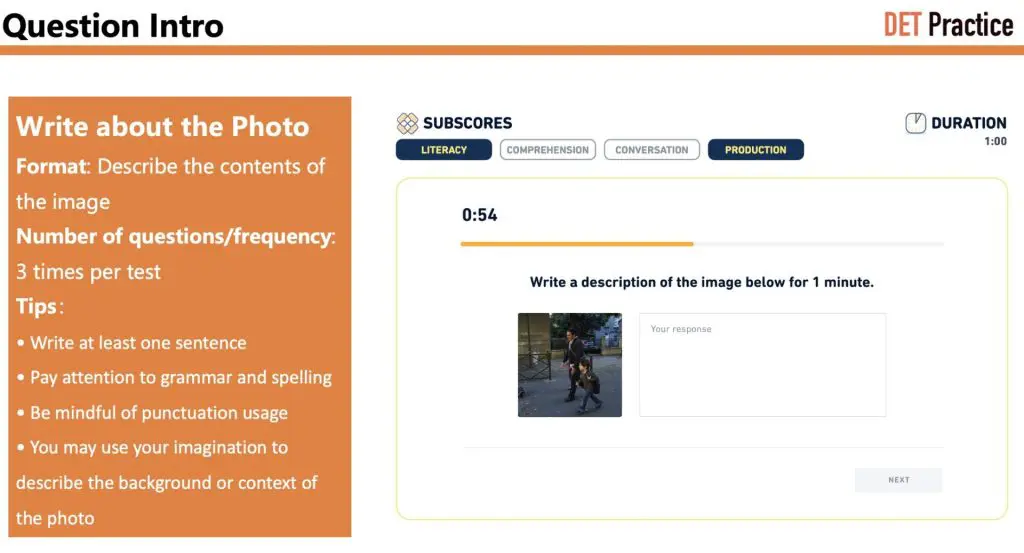
This task appears three times per test and is crucial for assessing your literacy and production skills.
In this task, you’ll be presented with an image and asked to describe its contents in just one minute. Let’s break down what you need to know:
First, the format is straightforward – describe what you see in the photo. But here’s the key: you’re not just listing objects. We want you to craft a meaningful description.
Now, let’s talk strategy. You should aim to write at least one complete sentence. This shows you can form coherent thoughts in English. Pay close attention to your grammar and spelling – these are essential components of your literacy score.
Punctuation is also critical. Proper use of periods, commas, and other punctuation marks demonstrates your understanding of English writing conventions.
Here’s a pro tip: don’t be afraid to use your imagination. While you should primarily describe what you see, you can also speculate about the background or context of the photo. This can help you create a more engaging and complete response.
Overview of Question Categories
Now, let’s dive into the question categories you’ll encounter in the ‘Write About the Photo’ section. Understanding these categories will help you prepare more effectively and respond more comprehensively.
The DET Practice exam breaks down into four main categories:
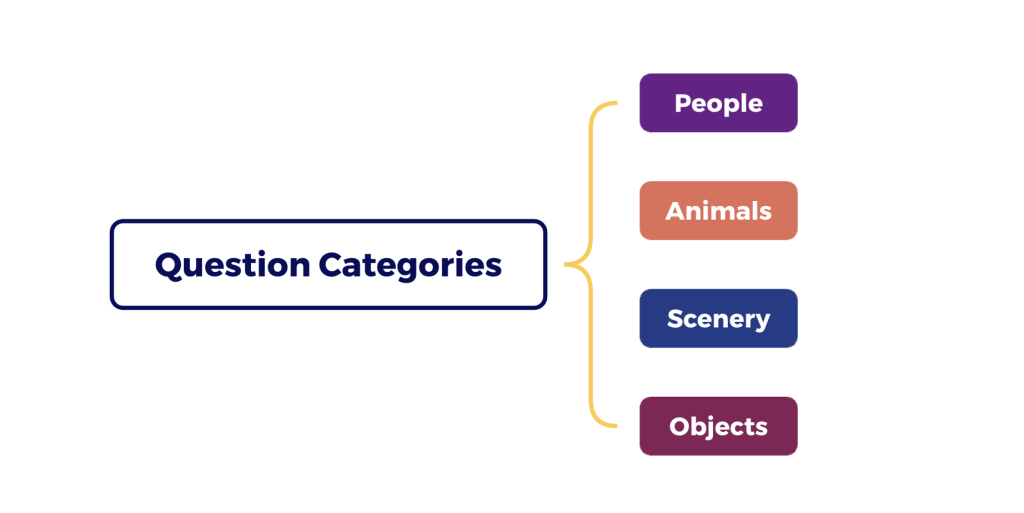
In the next section, we’ll look at some specific strategies for tackling each of these question categories effectively.
Mastering People-Related Questions
First,”Let’s focus on the people-related questions, which are often the most common in the ‘Write About the Photo’ section. We can break these down into three subcategories:

Now, let’s go through the steps for answering people-related questions effectively:
Step 1: Observe the image carefully. Identify basic information about the person, such as their gender, approximate age, possible occupation, clothing, facial expression, and posture. This step is crucial as it forms the foundation of your description.
Step 2: Use one sentence to summarize the background story of the image or the personality traits of the person. This is where you can make inferences based on what you see. For example, if you see a person in a suit rushing down a city street, you might infer they’re a busy professional heading to an important meeting.
Step 3: Describe the person’s actions or emotions if they’re visible in the image. This adds depth to your description and shows you can interpret non-verbal cues.
Now, let’s focus on a specific template for answering people-related questions, particularly those centered on facial features, appearance, and emotions. Remember, while we’ve been discussing speaking, this task actually requires you to write about the photo.
Answer template for people-related questions (focusing on facial features/appearance/emotions):
The template provided uses two colors: blue for the sentence structure, and red for the parts you’ll need to customize based on the image. This color-coding helps you quickly identify where to insert your specific observations.
Let’s break down the template:
‘Spotlighted in this photo is/are a [group individual] with [describe external characteristics], their appearance speaking volumes about their [cultural background personality].’
This sentence allows you to start with a broad description, noting whether you’re describing an individual or a group, their key physical features, and what these might suggest about their background or personality.
‘In the heart of the image is/are a [group/individual] showcasing [describe external characteristics], offering insight into their [personal style/identity].’
This sentence focuses more on the central subject of the image, their appearance, and what it might reveal about their personal style or identity.
‘The focal point of the snapshot is/are a [group/individual], their face lit up with [describe emotion], a clear reflection of their [inner state/situation].’
Here, you’re zeroing in on the subject’s facial expression and the emotion it conveys, linking it to their possible inner feelings or circumstances.
‘Featured in this picture is/are a [group/individual], their eyes shining with [describe emotion], giving away their [inner state/situation].’
This final sentence allows you to focus specifically on the subject’s eyes and what they might reveal about the person’s emotional state or situation.
When using this template, remember to vary your word choice and sentence structure to avoid repetition. You don’t need to use all four sentences – choose the ones that best fit the image you’re describing.
Now, let’s look at some useful vocabulary for describing people in your photo descriptions. This table provides a range of descriptive words categorized by age group and gender. These words will help you add depth and variety to your descriptions.
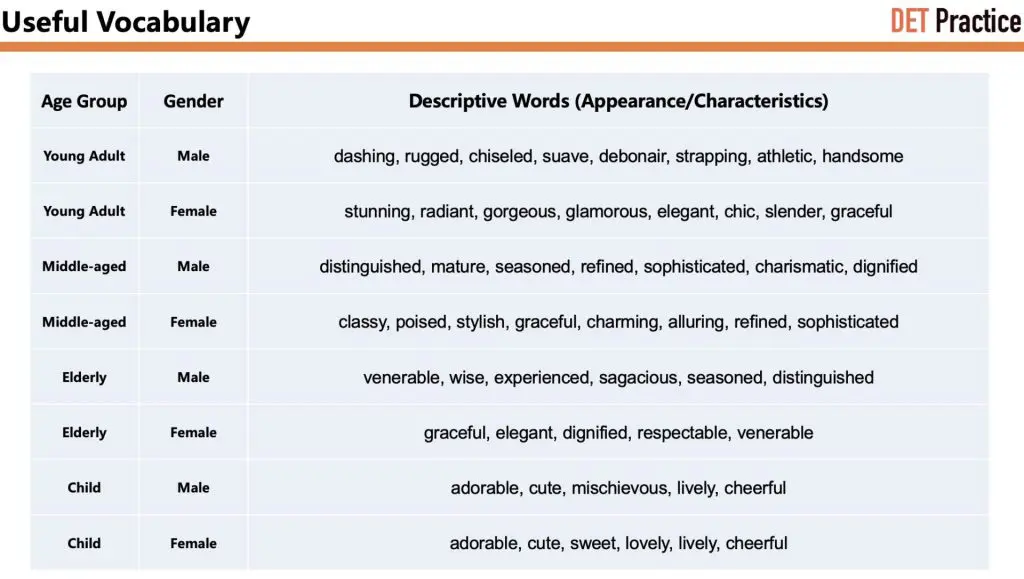
The table covers different age groups from children to elderly individuals, for both males and females. It offers a rich selection of adjectives to describe appearance and characteristics.
For example, when describing a young adult male, you might use words like ‘dashing’, ‘rugged’, or ‘debonair’. For a middle-aged female, words like ‘classy’, ‘poised’, or ‘alluring’ could be appropriate. Having these words at your fingertips will help you quickly come up with vivid and varied descriptions during the test.
Remember, while these words are useful, it’s important to use them appropriately and in context. Always ensure your description accurately reflects what you see in the image.
Next, let’s look at another important aspect of describing people in photos: emotions. This table provides a range of descriptive words for various emotional states.
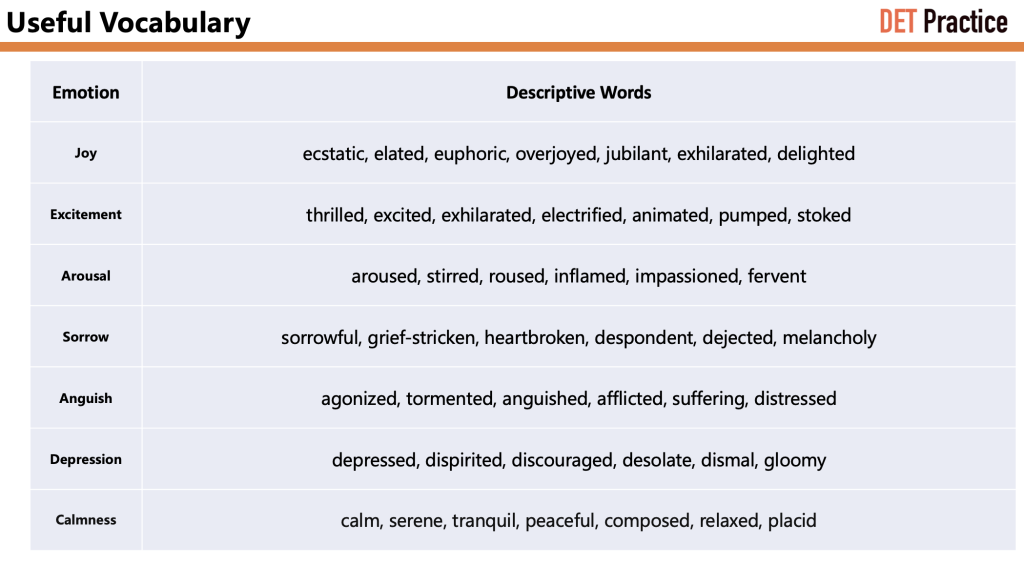
The table covers a wide spectrum of emotions, from joy and excitement to sorrow and depression.
Remember, when describing emotions in your photo descriptions, it’s important to base your observations on visible cues such as facial expressions, body language, or the context of the image. Using these descriptive words will add depth and nuance to your writing, helping you create more vivid and engaging descriptions.
Now, let’s focus on another crucial aspect of describing people in photos: clothing and accessories. This table provides an extensive list of vocabulary related to various items of clothing and accessories.
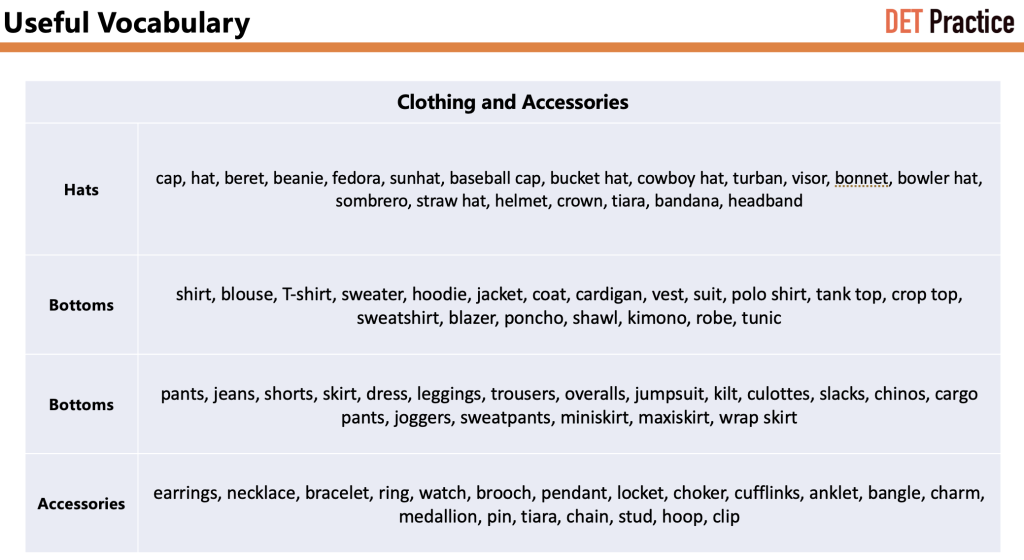
As with our previous vocabulary lists, I recommend save this table for future reference. It will be incredibly helpful when you need to describe what people are wearing in the photos you’ll be writing about.
Then, let’s focus on another crucial aspect of photo description: the setting. This table provides a rich vocabulary for describing both outdoor and indoor environments.
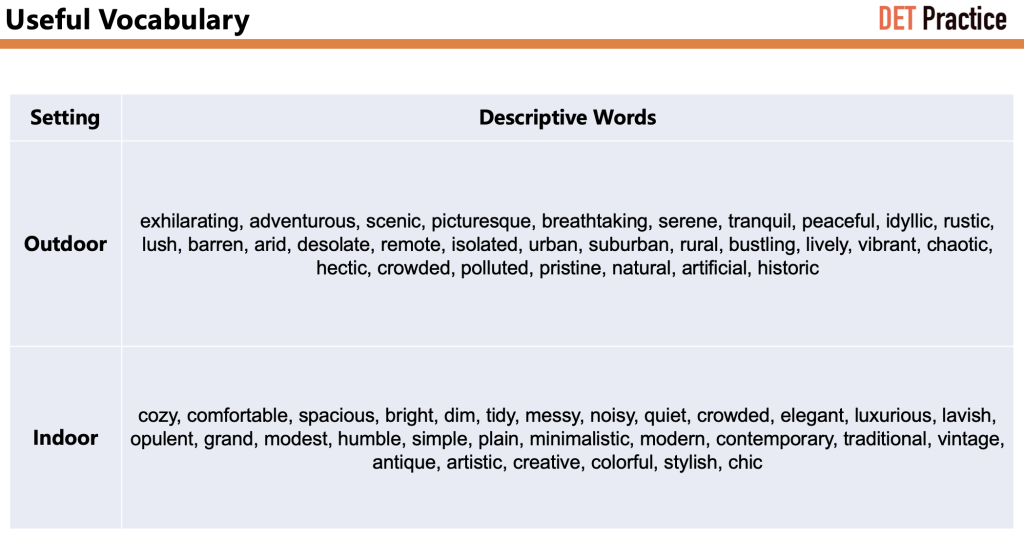
Now, let’s look at a sample question and how to apply the template we’ve discussed earlier. This example focuses on describing facial features, appearance, and emotions.

Let’s break down how this template is applied to the image:
In the sample answer, we see: ‘Spotlighted in this photo is an individual with long, flowing brown hair and a gentle smile, her appearance speaking volumes about her warm and approachable personality.’
This response effectively uses the template while incorporating specific details from the image. It describes the external characteristics (long, flowing brown hair and gentle smile) and makes an inference about the person’s personality (warm and approachable) based on these visual cues.
When using this template for your own responses, remember to:
Also, note how the response includes details about the subject’s hair and facial expression. These are key elements in describing a person’s appearance and can often provide insights into their mood or personality.
Now let’s look at another template and example for describing people in photos, still focusing on facial features, appearance, and emotions.
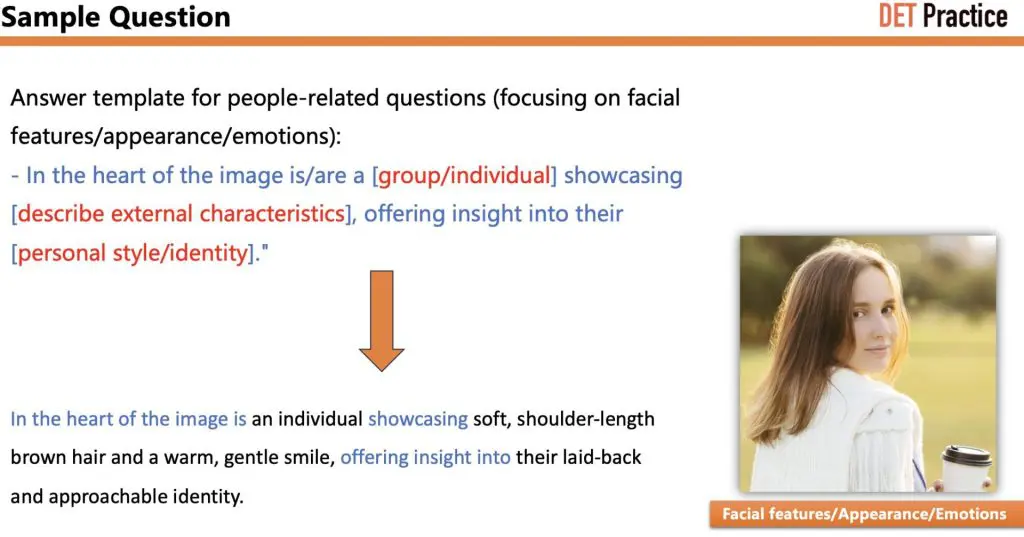
Let’s break down how this template is applied to the same image:
The sample answer reads: ‘In the heart of the image is an individual showcasing soft, shoulder-length brown hair and a warm, gentle smile, offering insight into their laid-back and approachable identity.’
This response effectively uses the new template while providing a slightly different perspective on the same image. Let’s analyze the key components:
Notice how this description adds more detail about the hair length and texture compared to the previous example. It also interprets the smile as ‘warm’ in addition to ‘gentle’, providing a more nuanced description of the person’s expression.
The inference about the person’s identity as ‘laid-back and approachable’ is drawn from these visual cues, demonstrating how appearance can be used to make reasonable assumptions about personality.
“Now let’s focus on describing the environment in people-related questions. This is crucial as the setting often provides context for the actions and emotions of the people in the photo. We have two templates to work with:
Answer template for people-related questions (focusing on describing the environment):
When using these templates, remember to:
These templates help you create a comprehensive picture of the environment, providing context for the human subject’s actions.
“Let’s examine how the template has been applied in this specific example:
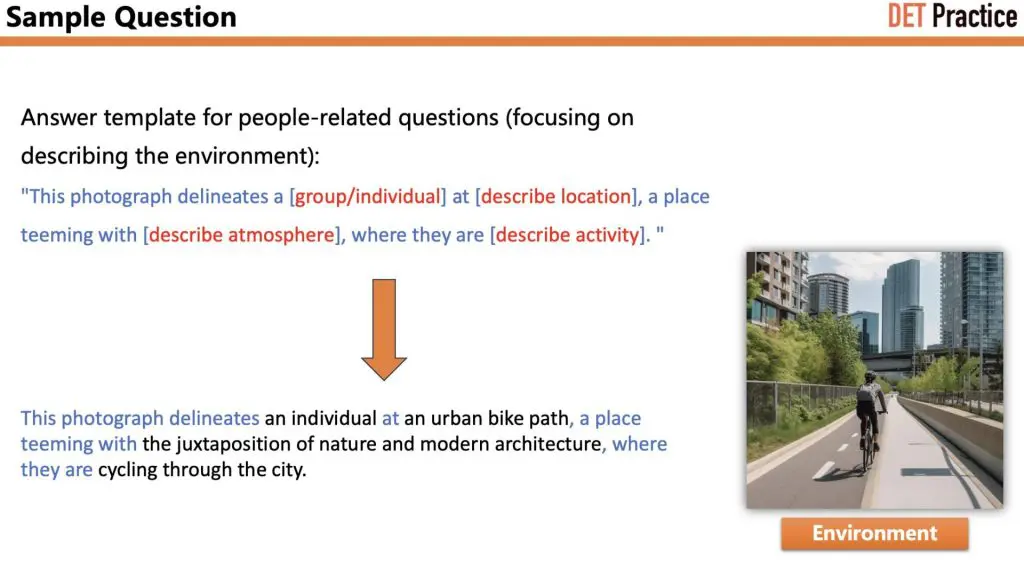
The response given is: ‘This photograph delineates an individual at an urban bike path, a place teeming with the juxtaposition of nature and modern architecture, where they are cycling through the city.’
This response effectively uses the template while providing a rich description of the environment. Let’s break it down:
The response does an excellent job of capturing the key elements of the environment:
When using this template for your own responses, remember to:
This template helps you create a comprehensive picture of the environment, providing context for the human subject’s actions. In your practice, try to combine this environmental description with details about the person (their appearance, clothing, etc.) to create even more detailed and engaging responses.
Now let’s examine how the second template has been applied to describe the same image:
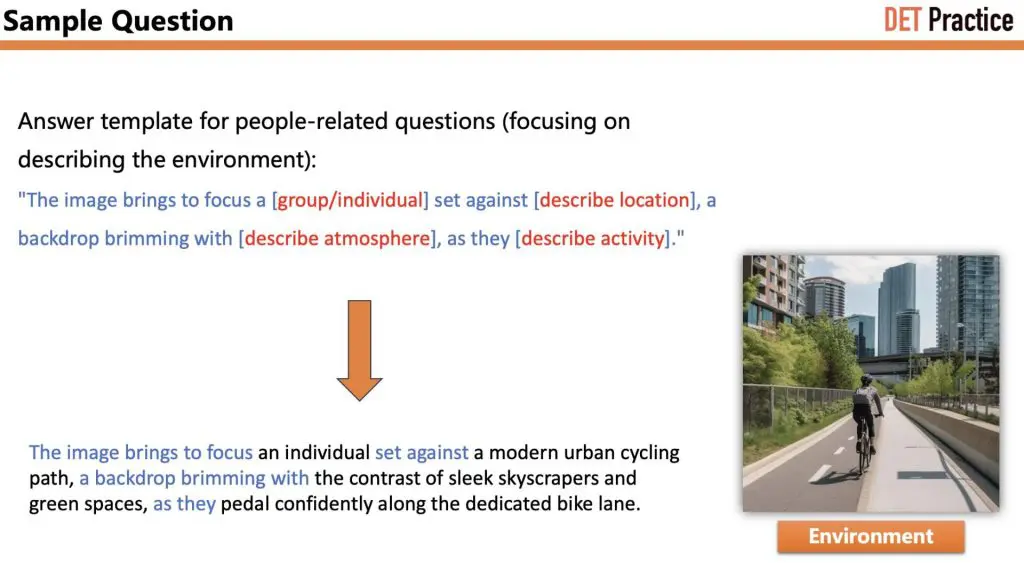
The response given is: ‘The image brings to focus an individual set against a modern urban cycling path, a backdrop brimming with the contrast of sleek skyscrapers and green spaces, as they pedal confidently along the dedicated bike lane.’
This response effectively uses the template while providing a rich and detailed description of the environment. Let’s break it down:
This response excels in several ways:
When using this template for your own responses, remember to:
This template allows you to create a comprehensive and engaging description of the environment while also capturing the subject’s action within it. In your practice, try to combine this environmental description with details about the person’s appearance or clothing to create an even more detailed and well-rounded response.
Now let’s focus on describing actions and behaviors in people-related questions. This is crucial as actions often reveal a person’s emotions, interests, or abilities. We have two templates to work with:
Answer template for people-related questions (focusing on describing actions):
These templates help you create a vivid description of the action while also providing insights into the subject’s character or emotions. In your practice, try to combine these action descriptions with details about the person’s appearance and the environment to create even more comprehensive and engaging responses.”
Let’s examine how the template has been applied in this specific example:
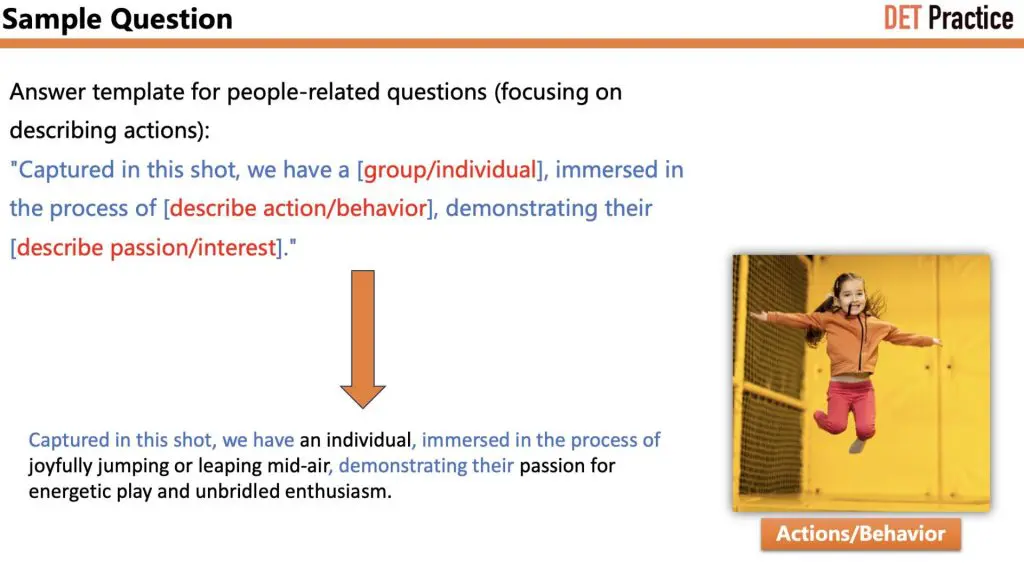
The response given is: ‘Captured in this shot, we have an individual, immersed in the process of joyfully jumping or leaping mid-air, demonstrating their passion for energetic play and unbridled enthusiasm.’
This response effectively uses the template while providing a vivid description of the action and what it reveals about the individual. Let’s break it down:
The response excels in several ways:
This template allows you to create a comprehensive and engaging description of the action while also providing insights into the subject’s character or interests. In your practice, try to combine this action description with details about the person’s appearance or the environment to create an even more detailed and well-rounded response.
Let’s examine how the second template has been applied to describe the same image:
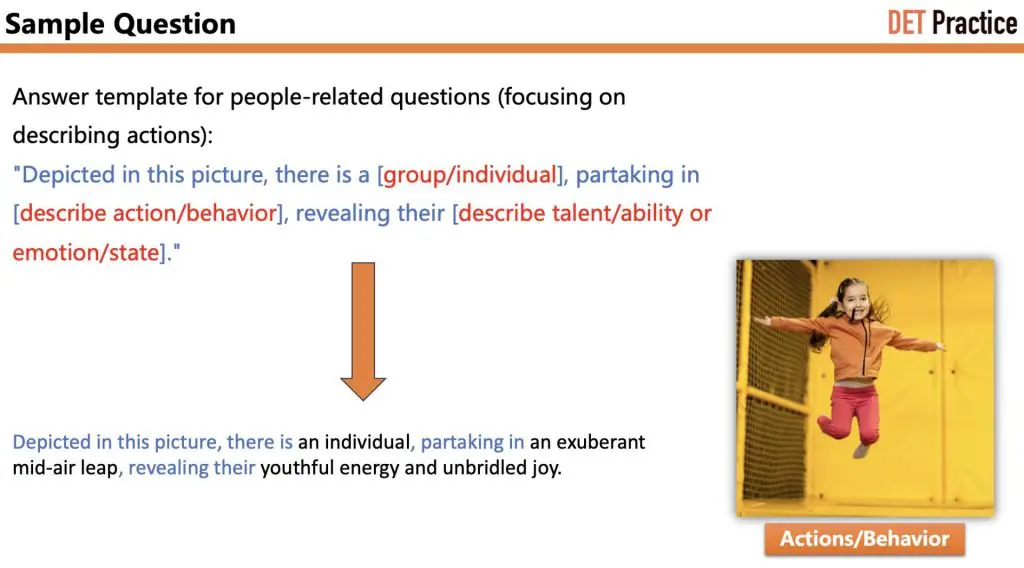
The response given is: ‘Depicted in this picture, there is an individual, partaking in an exuberant mid-air leap, revealing their youthful energy and unbridled joy.’
This response effectively uses the template while providing a vibrant description of the action and what it reveals about the individual.
When using this template for your own responses, consider:
This template allows you to create an engaging description of the action while also providing insights into the subject’s emotional state or abilities. In your practice, try incorporating details about the person’s appearance or the setting to craft a more comprehensive response.
Describing Animals in Photos

Next, let’s discuss the “animal” category within the “write about the photo” task, let’s focus on how to approach animal-related questions in image descriptions. These guidelines will help you provide comprehensive and insightful descriptions of animals in photographs. The approach is divided into three main steps:
This step involves:
Remember, these steps should be applied flexibly based on the specific image and question at hand. Not all elements will be relevant for every animal photo, so use your judgment to focus on the most pertinent aspects of each image.
Move on to response templates for describing a single animal in an image. These templates provide a structured approach to crafting detailed and engaging descriptions. Here are three templates you can use:
Template 1 emphasizes the animal’s action, habitat, and a standout feature that reveals something about its nature or emotional state.
Template 2 focuses on the animal’s action and its environment, while also highlighting how the animal interacts with its surroundings to reveal something about its behavior.
Template 3 puts emphasis on the overall mood of the image, using the animal’s pose and the background to create a more evocative description.
These templates are flexible and can be adapted based on the specific details of the image you’re describing. Use them as a starting point to ensure you cover key aspects of the animal and its surroundings.
Next, let’s look at response templates for describing multiple animals in an image. These templates provide a structured approach to crafting detailed and engaging descriptions for scenes with more than one animal. Here are three templates you can use:
Template 1 emphasizes the animals’ collective action, their shared habitat, and a common feature that reveals something about their nature or emotional state.
Template 2 focuses on the individual actions of the animals and their environment, while also highlighting how they interact with each other or their surroundings to reveal something about their behavior or social relationships.
Template 3 puts emphasis on the overall mood of the image, using the animals’ collective pose and the background to create a more evocative description.
Then, let’s examine how the template has been applied to describe this specific image of a cat:
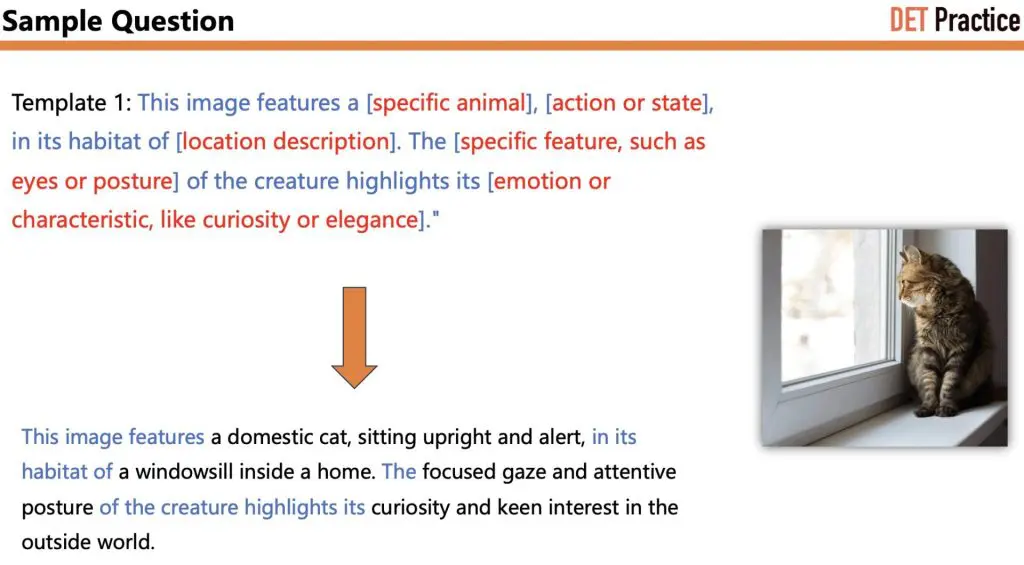
The response given is: ‘This image features a domestic cat, sitting upright and alert, in its habitat of a windowsill inside a home. The focused gaze and attentive posture of the creature highlights its curiosity and keen interest in the outside world.’
This response effectively uses the template while providing a rich description of the cat and its environment.
It uses specific language to describe the cat’s position and attitude (‘sitting upright and alert’).
It accurately describes the immediate environment (‘windowsill inside a home’).
It focuses on key features (gaze and posture) that reveal something about the cat’s mental state.
It makes a reasonable inference about the cat’s emotions and interests based on its observed behavior.
This template allows you to create a comprehensive and engaging description of an animal in its environment while also providing insights into its behavior and possible mental state.
Next, we have template 2. It’s a framework guiding us on how to describe an image systematically. Notice the color-coded parts – they’re our key focus areas.
The template starts with “Captured in this photo are [specific animals].” This prompts us to identify the main subjects.
Next, we describe their actions, followed by a brief description of the environment.
Finally, we interpret their interactions, revealing insights about behavior or social dynamics.
Now, let’s look at the example. We have a photo of two brown bears in a grassy field.
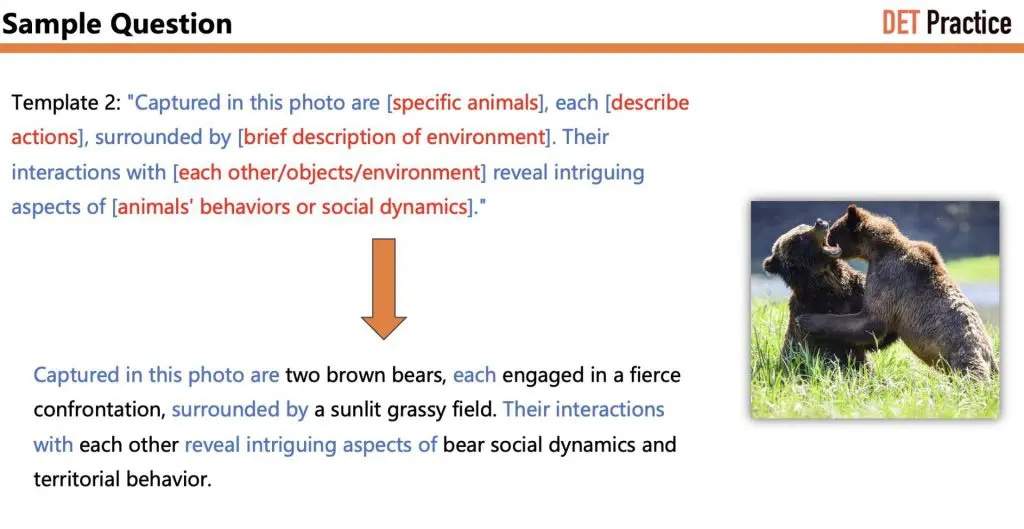
Here is the response: Captured in this photo are two brown bears, each engaged in a fierce confrontation, surrounded by a sunlit grassy field. Their interactions with each other reveal intriguing aspects of bear social dynamics and territorial behavior.
See how the answer follows our template perfectly? It identifies the animals, describes their action – “engaged in a fierce confrontation,” mentions the setting – “a sunlit grassy field,” and interprets their behavior – “revealing intriguing aspects of bear social dynamics and territorial behavior.”
This structured approach helps you create detailed, coherent descriptions. It’s not just about what you see, but also what you can infer from the image.
Moving on,let’s dive into the structure of Template 3. It begins with “This striking image presents…” – immediately setting a tone of visual impact. From there, we identify the specific animals in the image and describe their actions or poses. The template then guides us to paint a picture of the background using the phrase “set against the vivid backdrop of…”. Finally, we’re encouraged to convey the emotional atmosphere and highlight specific features that emphasize this feeling.
Now, let’s see how this template comes to life with our example image of the dogs.
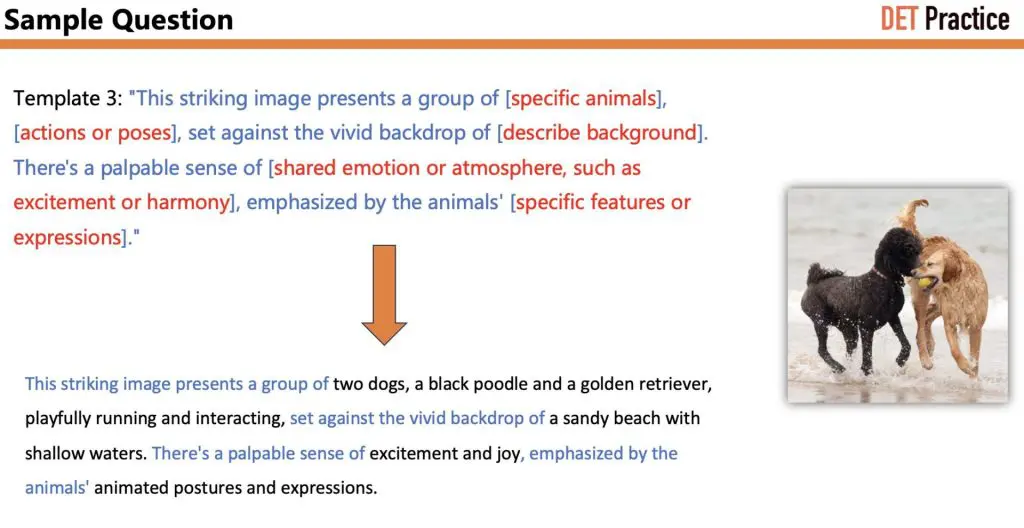
The description reads: “This striking image presents a group of two dogs, a black poodle and a golden retriever, playfully running and interacting, set against the vivid backdrop of a sandy beach with shallow waters. There’s a palpable sense of excitement and joy, emphasized by the animals’ animated postures and expressions.”
This template is fantastic for developing more sophisticated language skills. It encourages the use of vivid adjectives, emotive language, and detailed observations. Remember, the goal isn’t just to list what you see, but to paint a picture with words.
Capturing Scenery in Words
Continuing our breakdown of the “write about the photo” categories, let’s now examine the scenery-type questions.

First, we’ll look at some Approach Guidelines for Scenery-Related Questions, let’s break down the three-step process for tackling scenery-related questions:
Step 1 is all about the big picture. When you first look at an image, take a moment to absorb the overall scene. What’s the general atmosphere? Is it a serene countryside, a bustling cityscape, or perhaps a dramatic natural wonder? Try to capture the mood the picture conveys. Is it peaceful, energetic, mysterious, or awe-inspiring?
Moving on to Step 2, we dive into the details. Here’s where you’ll want to identify and describe the main elements of the image. Look for key features like the sky – is it clear blue or filled with clouds? Are there mountains in the background, or perhaps a shimmering lake in the foreground? Don’t forget to mention any buildings, trees, or other prominent objects that define the scene.
Finally, Step 3 gives you a chance to add your personal touch. This step is optional, but it can really make your description stand out. Share your impressions of the image. How does it make you feel? Does it remind you of somewhere you’ve been? Maybe you can comment on the photographer’s skill in capturing the scene.
Now that we’ve covered the approach guidelines, let’s enhance our descriptive skills with some powerful vocabulary. This supplement will help you paint vivid pictures with your words when describing scenery.
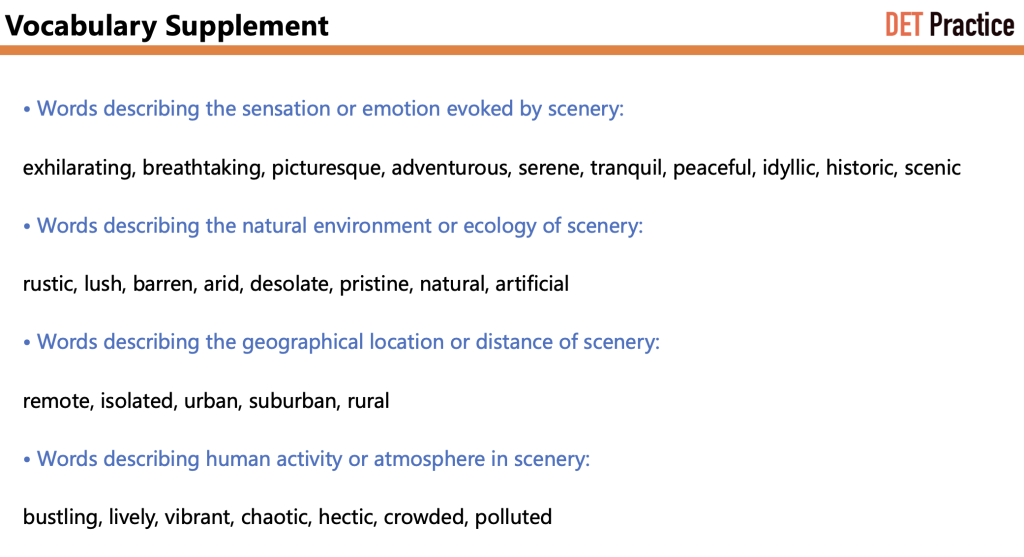
Remember, the key to using these words effectively is to choose the ones that best match the specific scene you’re describing. Practice using these words in your descriptions, and you’ll find your vocabulary becoming richer and more expressive.
Then let’s explore some powerful templates for responding to scenery-related questions. These templates will help you structure your descriptions in a sophisticated and engaging manner.
Scenery Question Response Templates:
Our first template starts with a strong opening: “This panorama is unequivocally [adjective].” You might say “breathtaking” for a stunning mountain vista, or “serene” for a peaceful lakeside scene. Then, highlight a distinctive feature, such as “undulating terrain” or “crystal-clear waters.” Conclude by relating it to a broader theme, like “rural charm” or “natural beauty.”
For our second template, we begin by setting the scene: “Encompassed by [surrounding environment].” This could be “arid plains” or “bustling main streets,” depending on your image. Then, describe the emotional impact: “The vista offers an [adjective] insight into [concept or theme].” You might say it offers an “exhilarating insight into adventure exploration.” Finally, focus on a prominent feature: “The [object/feature] looms majestically in the backdrop.”
Our third template is perfect for complex scenes. Start with “At first glimpse, the landscape is a heterogeneous amalgamation of [elements].” This works well for scenes mixing natural and man-made features. Then, relate this to a theme, such as “the fusion of urban and rural life.” Conclude with your personal response: “One can’t help but feel [personal impression] by the [feature],” and tie it to a broader concept like “human ingenuity” or “nature’s splendor.”
Remember, these templates are flexible. Feel free to mix and match elements to best suit the scene you’re describing. The key is to practice using them until they become second nature.
Now, let’s put our learning into practice with a real example. We have an image of a tranquil lake scene with mountains and trees, and we’ll use Template 1 to describe it.
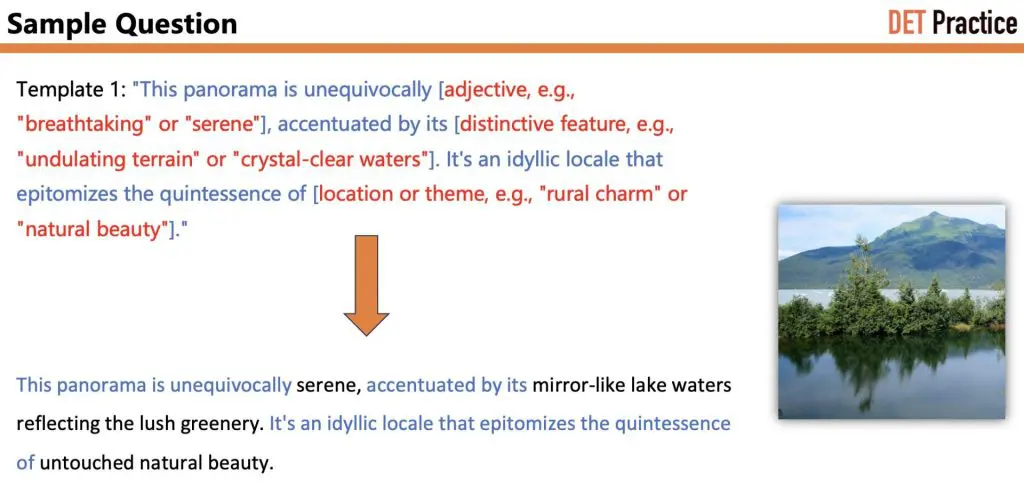
Let’s break down the response:
“This panorama is unequivocally serene,” – Here, we’ve chosen ‘serene’ as our opening adjective. It perfectly captures the calm, peaceful atmosphere of the lake scene.
“accentuated by its mirror-like lake waters reflecting the lush greenery.” – This part highlights the distinctive feature of the scene. The smooth, reflective surface of the lake is a key element, and the description of it mirroring the surrounding greenery adds a vivid detail.
“It’s an idyllic locale that epitomizes the quintessence of untouched natural beauty.” – This final sentence ties the scene to a broader theme. By describing it as ‘idyllic’ and emphasizing its ‘untouched natural beauty’, we’re conveying the pristine, unspoiled quality of the landscape.
Notice how this description follows our template while being tailored to the specific image. It gives a clear overall impression, focuses on a key feature, and links to a broader theme, all in just two sentences.
This approach allows us to create a rich, evocative description efficiently. It’s not just about listing what you see, but about conveying the feeling and essence of the scene.
Remember, while using templates can be helpful, it’s important to adapt them to suit each unique image. The goal is to use them as a guide to structure your thoughts, not as a rigid formula.
Excellent! Let’s continue by analyzing this new sample question and response using Template 2:
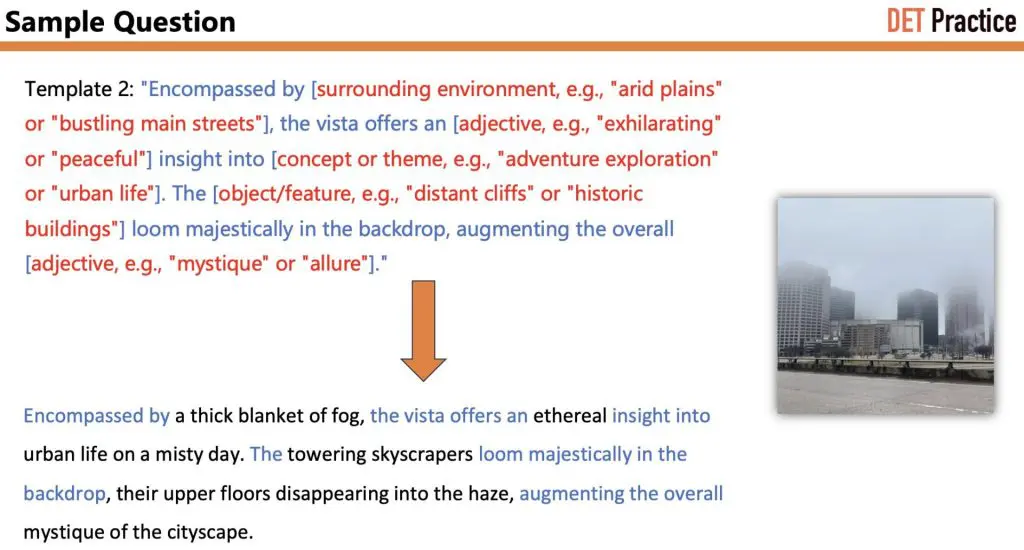
This is a very different scene – an urban landscape shrouded in fog.
Let’s break down the response:
“Encompassed by a thick blanket of fog,” – This opening phrase immediately sets the scene, describing the surrounding environment. The use of “thick blanket” vividly conveys the density of the fog.
“the vista offers an ethereal insight into urban life on a misty day.” – Here, we’ve used “ethereal” as our descriptive adjective, perfectly capturing the dreamlike quality of the foggy cityscape. The phrase “insight into urban life on a misty day” links the scene to the broader theme of city living under specific weather conditions.
“The towering skyscrapers loom majestically in the backdrop,” – This part follows the template by describing a key object or feature of the scene. The word “loom” is particularly effective, suggesting the imposing presence of the buildings even through the fog.
“their upper floors disappearing into the haze, augmenting the overall mystique of the cityscape.” – This final part adds more detail about the key feature and ties it to the overall impression. The image of the buildings disappearing into the fog enhances the sense of mystery and intrigue.
Notice how this description, while following the template, is tailored to the specific image. It captures not just what can be seen, but also the atmosphere and feeling evoked by the scene.
This approach allows us to create a rich, evocative description that goes beyond merely listing the visible elements. It conveys the mood, the essence of the urban environment, and the interplay between the built environment and natural weather conditions.
Now, let’s examine how we can apply Template 3 to describe a scene that combines natural and man-made elements – a park setting with a bench and table.
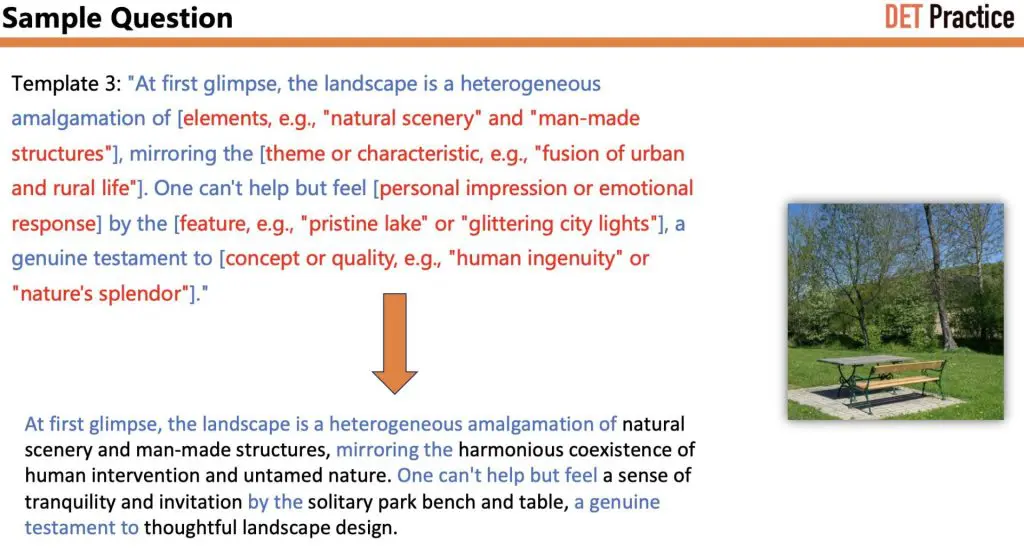
Let’s break down the response:
“At first glimpse, the landscape is a heterogeneous amalgamation of natural scenery and man-made structures,” – This opening follows the template exactly, immediately highlighting the mix of natural and artificial elements in the scene.
“mirroring the harmonious coexistence of human intervention and untamed nature.” – Here, we’ve identified the theme of the image: the balance between human influence and natural growth. The word “harmonious” emphasizes that these elements work well together.
“One can’t help but feel a sense of tranquility and invitation by the solitary park bench and table,” – This part expresses the personal impression or emotional response evoked by the scene. The choice of “tranquility and invitation” captures both the peaceful atmosphere and the welcoming nature of the seating area.
“a genuine testament to thoughtful landscape design.” – The description concludes by linking the scene to a broader concept – in this case, the art of landscape design. The word “thoughtful” suggests that care and consideration went into creating this space.
Notice how this description, while adhering to the template, is carefully tailored to the specific image. It not only describes what can be seen but also interprets the scene’s significance and emotional impact.
This approach allows us to create a rich, multi-layered description that goes beyond surface-level observation. It invites the reader or listener to consider the interplay between natural and man-made elements, and the purpose behind the design of public spaces.
Detailed Object Descriptions
Finally, let’s take a look at the “object” category in the “write about the photo” task. Let’s continue by introducing these Approach Guidelines for Object-Related Questions:

Now that we’ve mastered describing scenery, let’s turn our attention to a different but equally important skill: describing objects. Whether you’re talking about a household item, a piece of technology, or a work of art, these guidelines will help you create detailed and engaging descriptions.
Let’s break down the three-step approach:
Step 1: Careful Observation
This step is all about using your eyes. Take a moment to really look at the object. What are its main features? Pay close attention to its shape – is it round, square, irregular? What about its color – is it a single color or multi-colored? And don’t forget texture – is it smooth, rough, shiny? These details will form the foundation of your description.
Step 2: Identify Key Characteristics and Relationships
Now, think about what makes this object unique or interesting. What are its standout features? Also, consider how it relates to other objects. Is it part of a set? Is it similar to or different from other objects in its category? This step helps you decide what’s most important to include in your description.
Step 3: Logical Description
This is where you put it all together. Describe the object’s appearance, structure, and function in a logical order. Start with the overall appearance, then move to more specific details. Don’t forget to mention its purpose or function if relevant.
To make your description more vivid and comprehensive, use techniques like similes (comparing the object to something familiar), contrasts (highlighting differences), and lists (enumerating features or parts).
Now that we’ve covered the approach guidelines, let’s explore three versatile templates you can use to structure your responses to object-related questions. These templates will help you create comprehensive and engaging descriptions of various objects.
Template 1 helps you start with a general observation, then move into specific details about the object’s appearance, and finally connect these details to the object’s purpose or significance.
Template 2 encourages you to consider the object in relation to its surroundings and how its features contribute to its overall effect or function.
Template 3 prompts you to consider the object’s placement and context, and how these factors contribute to its broader significance or use.
Let’s continue our course by analyzing this sample question and response using Template 1: We can see a bathtub in a bathroom setting here.
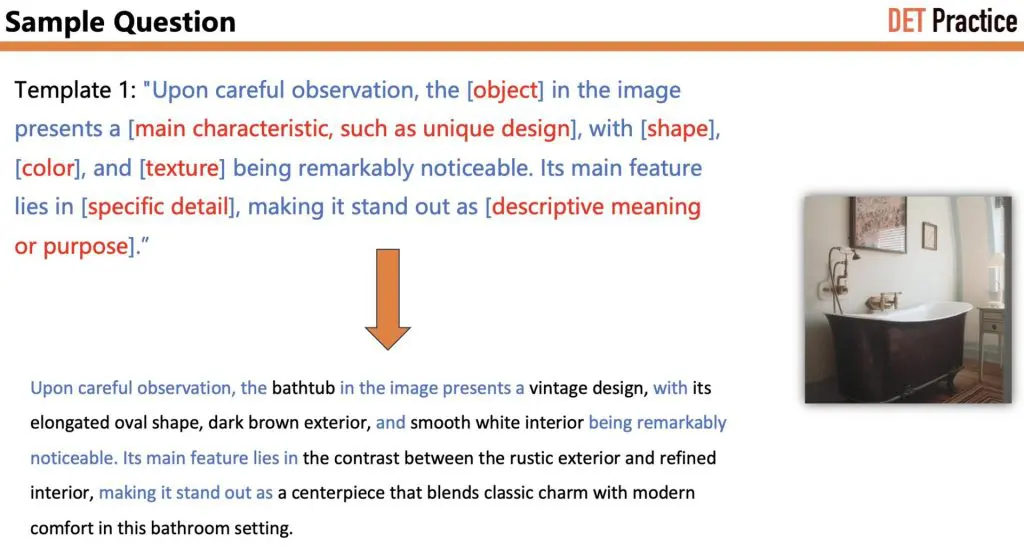
Let’s break down the response:
“Upon careful observation, the bathtub in the image presents a vintage design,” – This opening follows the template exactly, immediately identifying the object and its main characteristic.
“with its elongated oval shape, dark brown exterior, and smooth white interior being remarkably noticeable.” – Here, we’ve described the shape, color, and texture of the bathtub, providing a clear visual description.
“Its main feature lies in the contrast between the rustic exterior and refined interior,” – This part highlights a specific detail that makes the bathtub unique and interesting.
“making it stand out as a centerpiece that blends classic charm with modern comfort in this bathroom setting.” – The description concludes by explaining the bathtub’s significance in the context of the room.
Notice how this description, while adhering to the template, is carefully tailored to the specific object and its setting. It not only describes what can be seen but also interprets the design choices and their effect on the overall aesthetic of the bathroom.
This approach allows us to create a rich, multi-layered description that goes beyond surface-level observation. It invites the reader or listener to consider the bathtub not just as a functional object, but as a design element that contributes to the room’s atmosphere.
Now, let’s examine how we can apply Template 2 to describe a set of wooden tableware. This template allows us to focus on the object’s characteristics and its relationship to its surroundings.

Let’s break down the response:
“Focusing on the wooden tableware depicted,” – This opening follows the template exactly, immediately identifying the object of focus.
“its natural and eco-friendly design and light brown color create a warm, rustic aesthetic,” – Here, we’ve identified the main characteristics (natural and eco-friendly design) and color, and described the specific effect they create (warm, rustic aesthetic).
“complemented by its simple, curved shapes and smooth texture.” – This part describes the shape and texture of the tableware, adding depth to our description.
“The relationship with other objects suggests a complete dining set intended for casual, possibly outdoor use,” – This sentence interprets the function and implication of the tableware based on its relationship with other objects in the image.
“adding to its versatile and environmentally conscious overall quality.” – The description concludes by summarizing the overall quality of the tableware set.
Notice how this description, while adhering to the template, is carefully tailored to the specific objects and their context. It not only describes what can be seen but also interprets the design choices and their implications for use and environmental impact.
Now, let’s examine how we can apply Template 3 to describe a fireplace. This template allows us to focus on the object’s physical characteristics, its relationship with its surroundings, and its broader significance.
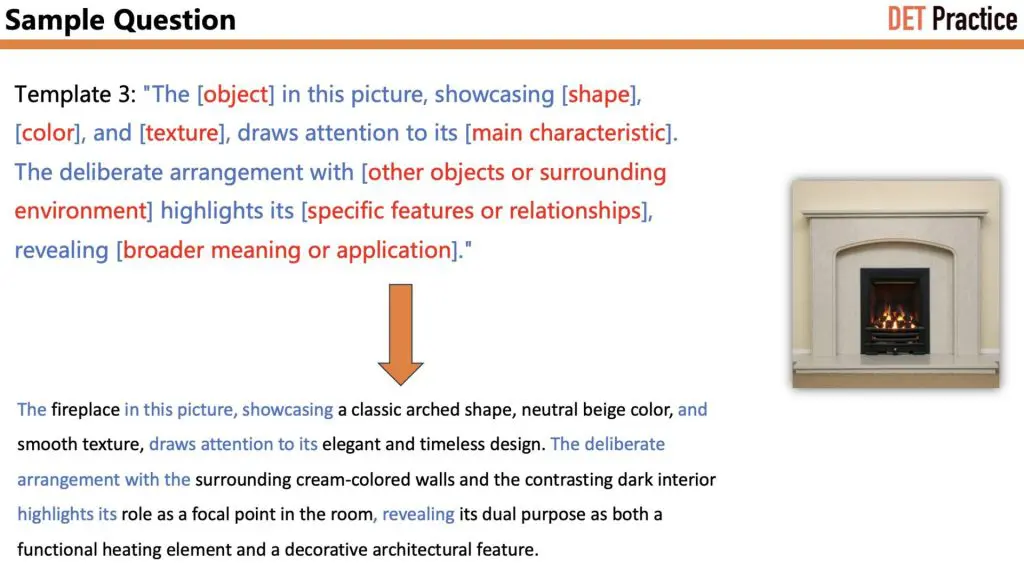
Let’s break down the response:
“The fireplace in this picture, showcasing a classic arched shape, neutral beige color, and smooth texture,” – This opening follows the template exactly, immediately identifying the object and its key physical attributes.
“draws attention to its elegant and timeless design.” – Here, we’ve identified the main characteristic that makes this fireplace stand out.
“The deliberate arrangement with the surrounding cream-colored walls and the contrasting dark interior” – This part describes how the fireplace relates to its immediate environment, highlighting the intentional design choices.
“highlights its role as a focal point in the room,” – This sentence interprets the function and importance of the fireplace within the space.
“revealing its dual purpose as both a functional heating element and a decorative architectural feature.” – The description concludes by explaining the broader meaning or application of the fireplace, emphasizing its multifaceted role.
Notice how this description, while adhering to the template, is carefully tailored to the specific object and its context. It not only describes what can be seen but also interprets the design choices and their implications for the room’s overall aesthetic and functionality.
This approach allows us to create a rich, multi-layered description that goes beyond surface-level observation. It invites the reader or listener to consider the fireplace not just as a standalone object, but as an integral part of the room’s design and purpose.
Remember, the key to using these templates effectively is to adapt them to each unique object, choosing words and phrases that best capture the specific elements, appearance, and significance of the item you’re describing.
Putting It All Together: Practice and Conclusion
Excellent! Let’s wrap up our course by discussing this exercise that demonstrates the application of all three templates to describe the inflatable dolphin toy:
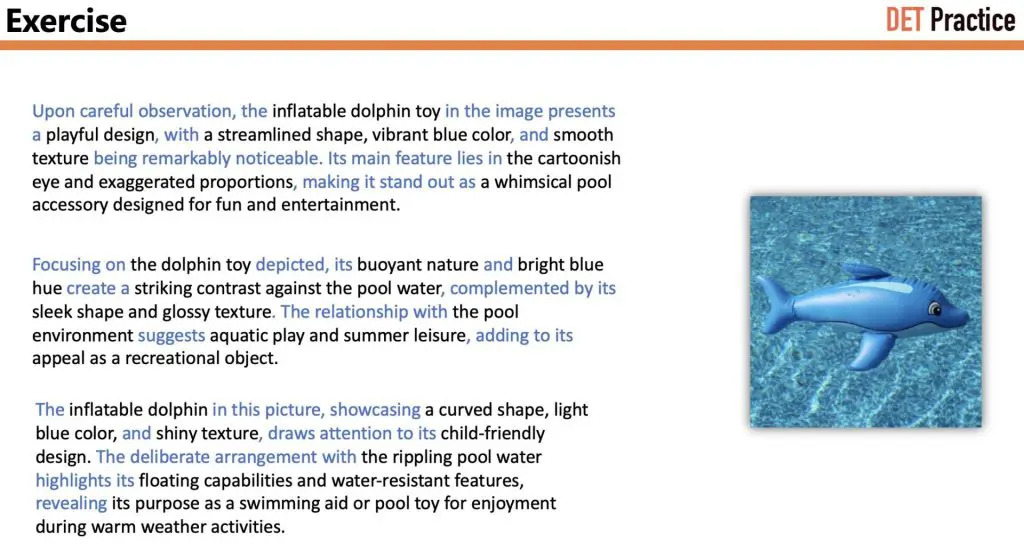
Now that we’ve explored all three templates, let’s look at how they can be applied to a single object – in this case, an inflatable dolphin toy. This exercise showcases how each template brings out different aspects of the object, providing a comprehensive description.
Template 1 focuses on the toy’s overall design and main features:
“Upon careful observation, the inflatable dolphin toy in the image presents a playful design, with a streamlined shape, vibrant blue color, and smooth texture being remarkably noticeable. Its main feature lies in the cartoonish eye and exaggerated proportions, making it stand out as a whimsical pool accessory designed for fun and entertainment.”
Template 2 emphasizes the toy’s relationship with its environment:
“Focusing on the dolphin toy depicted, its buoyant nature and bright blue hue create a striking contrast against the pool water, complemented by its sleek shape and glossy texture. The relationship with the pool environment suggests aquatic play and summer leisure, adding to its appeal as a recreational object.”
Template 3 highlights the toy’s purpose and broader application:
“The inflatable dolphin in this picture, showcasing a curved shape, light blue color, and shiny texture, draws attention to its child-friendly design. The deliberate arrangement with the rippling pool water highlights its floating capabilities and water-resistant features, revealing its purpose as a swimming aid or pool toy for enjoyment during warm weather activities.”
Notice how each template brings out different aspects of the toy:
By using all three templates, we’ve created a comprehensive description that covers the toy’s appearance, context, and purpose. This exercise demonstrates the versatility of these templates and how they can be used together to provide a thorough analysis of an object.
Remember, the key to mastering object description is practice. Try applying these templates to various objects in your daily life. With time, you’ll find yourself naturally incorporating elements from all three templates into your descriptions, creating rich, detailed, and insightful analyses of the objects around you.
Recap
Remember:
By mastering these techniques, test-takers can improve their ability to provide rich, insightful descriptions of various types of images, enhancing their performance on the Duolingo English Test. Thank you for joining us for this comprehensive guide on photo description. We hope that these templates and exercises will help you improve your descriptive skills. Good luck with your test.

